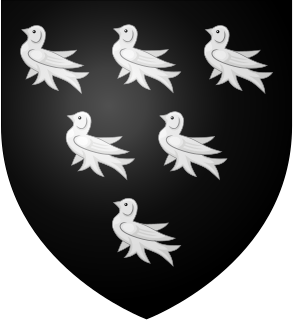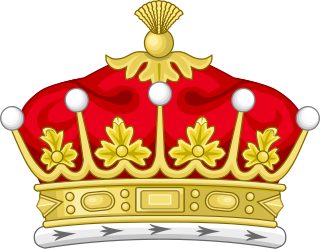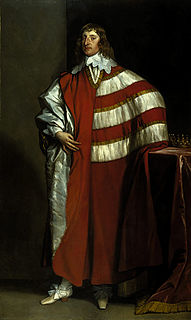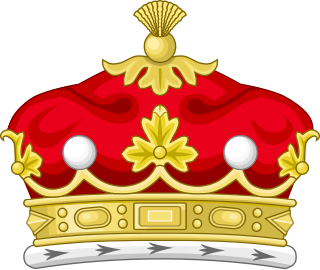 W
WBaron Arundell of Wardour, in the County of Wiltshire, was a title in the Peerage of England. It was created in 1605 for Thomas Arundell, known as "Thomas the Valiant", son of Sir Matthew Arundell and grandson of Sir Thomas Arundell and of Margaret Howard, a sister of Queen Catherine Howard. Arundell had already been created a Count of the Holy Roman Empire by Rudolph II in December 1595. He was succeeded by his son, the second Baron. He fought as a Royalist in the Civil War and was mortally wounded at the Battle of Stratton in 1643. His son, the third Baron, was implicated in the Popish Plot and imprisoned in the Tower of London for six years. However, after the accession of James II he was restored to favour and served as Lord Privy Seal from 1687 to 1688. His great-great-great-grandson, the eighth Baron, was an avid collector of art and accumulated immense debts in building and furnishing New Wardour Castle.
 W
WBaron Carew is a title that has been created three times. The first creation was in the Peerage of England in 1605. The first recipient, Sir George Carew (1555–1629), was later made Earl of Totnes in 1626. Both titles became extinct on his death as he left no heirs.
 W
WDuke of Devonshire is a title in the Peerage of England held by members of the Cavendish family. This branch of the Cavendish family has been one of the wealthiest British aristocratic families since the 16th century and has been rivalled in political influence perhaps only by the Marquesses of Salisbury and the Earls of Derby.
 W
WThe title Earl of Dunbar, also called Earl of Lothian or Earl of March, was the head of a comital lordship in south-eastern Scotland between the early 12th century and the early 15th century. The first man to use the title of Earl in this earldom was Gospatric II, Earl of Lothian, son of Gospatric, Earl of Northumbria. It descended to George de Dunbar, 11th Earl of March, who was forfeited by parliament of his titles & estates in 1435, and retired into obscurity in England. His son Patrick retained a barony at Kilconquhar in Fife.
 W
WEarl of Dunfermline was a title in the Peerage of Scotland. It was created in 1605 for Alexander Seton, 1st Lord Fyvie, fourth son of George Seton, 7th Lord Seton. Seton had already been created Lord Fyvie in the Peerage of Scotland, in 1598, with remainder to his elder brother, John Seton. He was succeeded by his son, the second Earl. He was Keeper of the Privy Seal of Scotland between 1661 and 1672. His younger son, the fourth Earl, was a supporter of the deposed James II and had his titles forfeited by parliament in 1690. He died in France in 1694 when the male line of the first Earl died out.
 W
WEarl of Home is a title in the Peerage of Scotland. It was created in 1605 for Alexander Home of that Ilk, 6th Lord Home. The Earl of Home holds, among others, the subsidiary titles of Lord Home, and Lord Dunglass (1605), in the Peerage of Scotland; and Baron Douglas, of Douglas in the County of Lanark (1875) in the Peerage of the United Kingdom. Various Earls of Home have also claimed the title of Lord Hume of Berwick. The Earl is also Chief of the Name and Arms of Home and heir general to the House of Douglas. The title Lord Dunglass is the courtesy title of the eldest son of the Earl.
 W
WMarquess of Exeter is a title that has been created twice, once in the Peerage of England and once in the Peerage of the United Kingdom. The first creation came in the Peerage of England in 1525 for Henry Courtenay, 2nd Earl of Devon. For more information on this creation, which was forfeited in 1538, see the Earl of Devon.
 W
WThe Earldom of Pembroke is a title in the Peerage of England that was first created in the 12th century by King Stephen of England. The title, which is associated with Pembroke, Pembrokeshire in West Wales, has been recreated ten times from its original inception. Due to the number of creations of the Earldom, the original seat of Pembroke Castle is no longer attached to the title.
 W
WEarl of Home is a title in the Peerage of Scotland. It was created in 1605 for Alexander Home of that Ilk, 6th Lord Home. The Earl of Home holds, among others, the subsidiary titles of Lord Home, and Lord Dunglass (1605), in the Peerage of Scotland; and Baron Douglas, of Douglas in the County of Lanark (1875) in the Peerage of the United Kingdom. Various Earls of Home have also claimed the title of Lord Hume of Berwick. The Earl is also Chief of the Name and Arms of Home and heir general to the House of Douglas. The title Lord Dunglass is the courtesy title of the eldest son of the Earl.
 W
WThe title of Viscount Lisle has been created six times in the Peerage of England. The first creation, on 30 October 1451, was for John Talbot, 1st Baron Lisle. Upon the death of his son Thomas at the Battle of Nibley Green in 1470, the viscountcy became extinct and the barony abeyant.
 W
WThe title Earl of Montgomery was created in the Peerage of England in 1605 for Sir Philip Herbert, younger son of the 2nd Earl of Pembroke. The first Earl inherited the Earldom of Pembroke in 1630 from his brother, the 3rd Earl, and the two titles remain united.Philip Herbert, 4th Earl of Pembroke, 1st Earl of Montgomery (1584–1649) Philip Herbert, 5th Earl of Pembroke, 2nd Earl of Montgomery (1621–1669) William Herbert, 6th Earl of Pembroke, 3rd Earl of Montgomery (1642–1674) Philip Herbert, 7th Earl of Pembroke, 4th Earl of Montgomery Thomas Herbert, 8th Earl of Pembroke, 5th Earl of Montgomery Henry Herbert, 9th Earl of Pembroke, 6th Earl of Montgomery (1693–1750) Henry Herbert, 10th Earl of Pembroke, 7th Earl of Montgomery (1734–1794) George Augustus Herbert, 11th Earl of Pembroke, 8th Earl of Montgomery (1759–1827) Robert Henry Herbert, 12th Earl of Pembroke, 9th Earl of Montgomery (1791–1862) George Robert Charles Herbert, 13th Earl of Pembroke, 10th Earl of Montgomery (1850–1895) Sidney Herbert, 14th Earl of Pembroke, 11th Earl of Montgomery (1853–1913) Reginald Herbert, 15th Earl of Pembroke, 12th Earl of Montgomery (1880–1960) Sidney Charles Herbert, 16th Earl of Pembroke, 13th Earl of Montgomery (1906–1969) Henry George Charles Alexander Herbert, 17th Earl of Pembroke, 14th Earl of Montgomery (1939–2003) William Alexander Sidney Herbert, 18th Earl of Pembroke, 15th Earl of Montgomery
 W
WEarl of Perth is a title in the Peerage of Scotland. It was created in 1605 for James Drummond, 4th Lord Drummond. The Drummond family claim descent from Maurice, son of George, a younger son of King Andrew I of Hungary. Maurice arrived in Scotland on the ship which brought Edgar Ætheling, the Saxon claimant to the crown of England after the Norman Conquest, and his sister Margaret to Scotland in 1068. Maurice was given lands in Lennox (Dunbartonshire), together with the hereditary stewardship of the county. The Hungarian Prince theory has been discounted as no evidence of any relationships exists in written records or DNA. "The Red Book of the Menteiths" clearly discounts the Hungarian Prince as a myth likely formed to give status to the Drummond origins. The Drummonds in the 12th Century were allied to the Menteiths – their early fortunes developed through the relationship. Indeed, one "Johannes De Drumon", said to have died in 1301, was buried in Inchmahome Priory which was founded by the Menteiths. His successor John Drummond, the 7th Steward, was deprived of the lands and retired into Perthshire.
 W
WEarl of Salisbury is a title that has been created several times in English and British history. It has a complex history, and is now a subsidiary title to the marquessate of Salisbury.
 W
WViscount of Stormont is a title in the Peerage of Scotland. It was created in 1621 by James VI for his friend and helper Sir David Murray who had saved him from the attack of the Earl of Gowrie in 1600. Murray had already been created Lord Scone, also in the Peerage of Scotland in 1605. The peerages were created with remainder to 1) Sir Mungo Murray, fourth son of John Murray, 1st Earl of Tullibardine, failing which to 2) John Murray, who was created Earl of Annandale in 1625, and failing which to 3) Sir Andrew Murray, who was created Lord Balvaird in 1641. Lord Stormont died childless and was succeeded according to the special remainder by the aforementioned Mungo Murray, the second Viscount. He died without male issue and was succeeded according to the special remainder by James Murray, 2nd Earl of Annandale, who now also became the third Viscount Stormont. He was the son of the aforementioned John Murray, 1st Earl of Annandale. He was also childless and on his death in 1658 the earldom became extinct.
 W
WDuke of York is a title of nobility in the Peerage of the United Kingdom. Since the 15th century, it has, when granted, usually been given to the second son of English monarchs. The equivalent title in the Scottish peerage was Duke of Albany. However, King George I and Queen Victoria granted the second sons of their eldest sons the titles Duke of York and Albany and Duke of York respectively.